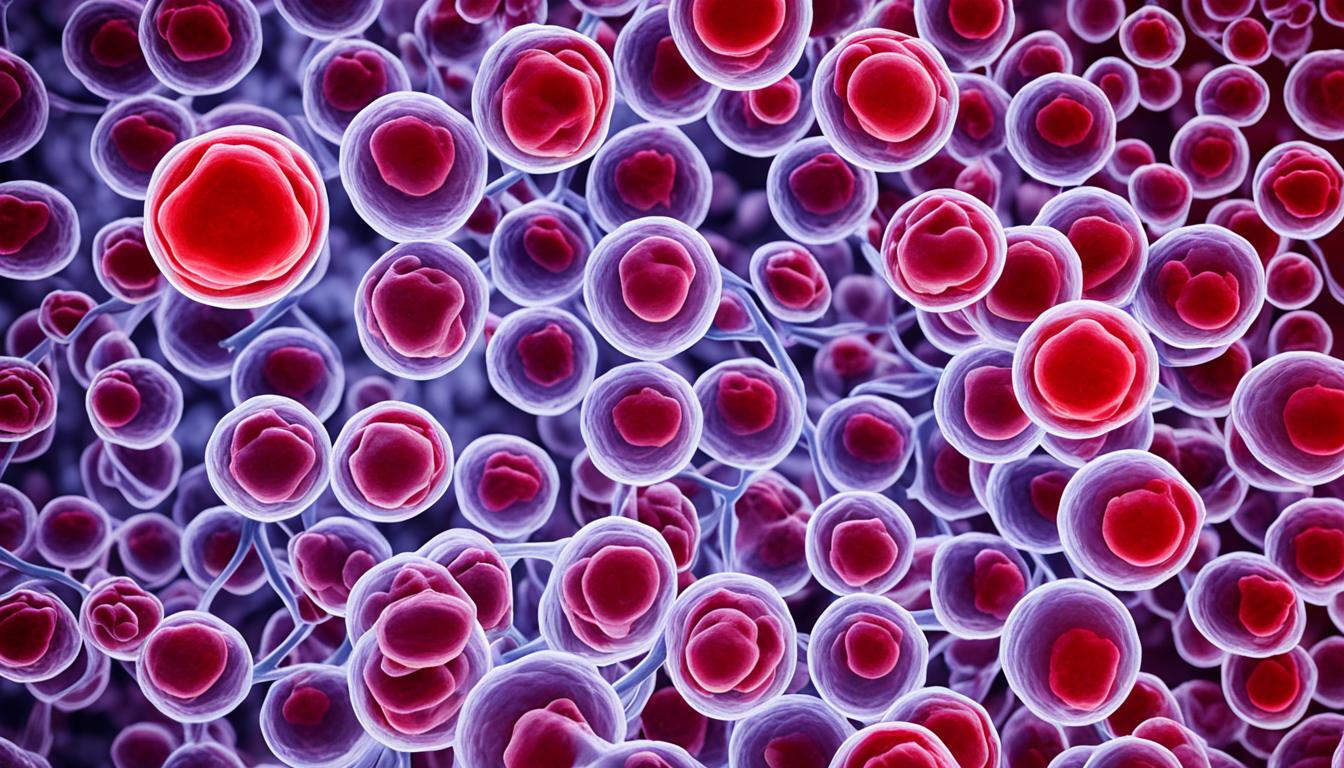Thrombocytosis is a condition where the body makes too many platelets. It has two types: one comes from another health issue, and the other is a disease of the blood and marrow. People with this might show symptoms like headaches, confusion, chest pain, and trouble breathing. They could also feel weak or have pain in their hands or feet. Bleeding from the nose, bruises, and mouth or gum bleeding are other signs.
The causes of thrombocytosis are many, such as blood loss, cancer, and infections. It can also be due to iron deficiency, surgery, or trauma. Finding out if it’s the reactive or essential kind helps with treatment. Sometimes, doctors may suggest stem cell therapy.
Key Takeaways:
- Thrombocytosis is a disorder characterized by excessive platelet production.
- There are two main types of thrombocytosis: reactive and essential thrombocythemia.
- Symptoms of thrombocytosis are often related to blood clotting and can include headache, confusion, chest pain, and weakness.
- The causes of thrombocytosis can vary, including blood loss, cancer, infections, and inflammatory disorders.
- Diagnosing the type of thrombocytosis is crucial for determining the appropriate treatment.
- Stem cell therapy may be considered for severe or refractory cases of thrombocytosis.
Types and Complications of Thrombocytosis
Thrombocytosis comes in two types: reactive and essential. Reactive thrombocytosis is more common. It happens due to things like blood loss, cancer, and infections. Essential thrombocythemia, however, appears for no known reason and might be tied to genetics.
Reactive thrombocytosis happens as a response to another health issue. Its treatment focuses on fixing the underlying problem. Meanwhile, essential thrombocythemia is a long-lasting condition that needs ongoing care.
Thrombocytosis, especially essential thrombocythemia, can be serious. It may cause dangerous blood clots leading to strokes and heart attacks. In rare situations, essential thrombocythemia could turn into leukemia.
Thrombocytosis can also affect pregnancy. It might raise the risk of miscarriage and other issues. This makes it important for pregnant women with thrombocytosis to be closely watched and managed.
Spotting and managing thrombocytosis early is key to avoid health risks. Following a treatment plan and regular check-ups are vital. This helps those with thrombocytosis stay healthy.
| Type | Causes |
|---|---|
| Reactive thrombocytosis | Underlying medical conditions such as blood loss, cancer, infections, iron deficiency, removal of the spleen, hemolytic anemia, and inflammatory disorders |
| Essential thrombocythemia | Unknown cause, but often associated with genetic changes |
Thrombocytosis can lead to serious complications. These can include:
- Increased blood clot risk
- Strokes
- Heart attacks
- Leukemia in rare cases
- Pregnancy problems like miscarriages
Taking a proactive approach to managing thrombocytosis is essential. This means regular checks and fitting treatment. These steps are crucial in lowering complication risks and enhancing patient outcomes.
Diagnosis and Treatment of Thrombocytosis
Diagnosing thrombocytosis starts with a blood test. This test is called a complete blood count (CBC). It checks the number of platelets in your blood. The result helps doctors see if you have thrombocytosis. More tests might be needed to find out why you have this condition.
The treatment for thrombocytosis depends on what’s causing it and how bad the symptoms are. If it’s caused by something else (reactive thrombocytosis), the main goal is to treat that. This could mean dealing with infections, controlling inflammation, or fixing low iron levels. Doing so can help ease your thrombocytosis symptoms.
For essential thrombocythemia, you might need medicines to manage your platelet levels and lower the risk of clots. It’s important to regularly check your platelet levels to avoid problems. In more serious cases, where other treatments have not worked, stem cell therapy could be an option.

